 PROVIDENCE, RI – December 16, 2021 – NVIDIA and grid-edge software company Utilidata said today they are developing a software-defined smart grid chip powered by NVIDIA’s AI platform and embedded in smart meters. The joint effort is designed to enhance grid resiliency, integrate distributed energy resources (DERs) — including solar, storage, and electric vehicles (EVs) — and accelerate the transition to a decarbonized grid.
PROVIDENCE, RI – December 16, 2021 – NVIDIA and grid-edge software company Utilidata said today they are developing a software-defined smart grid chip powered by NVIDIA’s AI platform and embedded in smart meters. The joint effort is designed to enhance grid resiliency, integrate distributed energy resources (DERs) — including solar, storage, and electric vehicles (EVs) — and accelerate the transition to a decarbonized grid.
Built on Utilidata’s experience with real-time grid operations, as well as the NVIDIA Jetson edge AI platform and the NVIDIA AI Enterprise software suite, the grid chip is designed to enable smart meters to deliver greater value to utilities and their customers, while also identifying opportunities for clean energy companies and third-party market participants, including incumbent meter manufacturers.
NVIDIA Jetson is an AI-at-the-edge computing platform used by over 850,000 developers, according to the company. Pretrained AI models, developer SDKs, and support for cloud-native technologies across the Jetson lineup allow developers to build and deploy software-defined features on embedded and edge devices targeting robotics, AIoT, smart cities, healthcare, energy and industrial applications. Cloud-native support for Jetson is intended to help Utilidata implement frequent improvements in accuracy and quickly deploy new algorithms throughout an application’s lifecycle, at scale, while minimizing downtime.
“Our collaboration with Utilidata and NREL to bring AI to grid edge operations will increase resiliency and reduce energy consumption and costs to consumers through new capabilities in meters,” said Marc Spieler, Head of Global Energy Business Development at NVIDIA. “With the availability of an open, software-defined meter platform, utilities and consumers will no longer be locked into closed, proprietary systems that hamper innovation by limiting third-party applications.”
The U.S. Department of Energy’s (DOE’s) National Renewable Energy Laboratory (NREL) will be among the first to test the software-defined smart grid chip as a way to scale and commercialize the lab’s Real-Time Optimal Power Flow (RT-OPF) technology, with support from the Solar Energy Technologies Office Technology Commercialization Fund. Originally developed with funding from DOE’s Advanced Research Projects – Energy (ARPA-E) program, RT-OPF enables highly localized load control to seamlessly integrate an increasing number of DERs while ensuring stable and efficient grid operations.
“To date, the scalability and commercial potential of technologies like RT-OPF have been limited by single-use hardware solutions,” said Santosh Veda, Group Manager for Grid Automation and Controls at NREL. “By developing a smart grid chip that can be embedded in one of the most ubiquitous utility assets – the smart meter – this approach will potential enable wider adoption and commercialization of the technology and redefine the role of edge computing for DER integration and resiliency. Enhanced situational awareness and visibility from this approach will greatly benefit both the end customers and the utility.”
The complexity of the power grid will grow as more distributed energy resources and intermittent renewables come online. Current meters lack the computing power necessary to support real-time, autonomous grid operations that will help achieve decarbonization goals and improve grid resiliency.
Utilidata is a developer of meter-based software, having developed on-meter applications for meter companies around the world. The company’s patented machine learning software leverages real-time data from smart meters and other distribution grid devices to detect anomalies that are precursors to system failures and outages, optimize grid operations, and integrate exponentially more DERs onto the utility system. The company is also a member of NVIDIA Inception, a program designed to nurture cutting-edge startups.
“To maximize the value of DERs and integrate these resources into grid operations, utilities are going to need decentralized solutions, like RT-OPF,” said Marissa Hummon, Chief Technology Officer at Utilidata. “Existing meters don’t have the computational power or communications bandwidth to support this kind of real-time operation. But combining our real-time grid software solutions with NVIDIA’s advanced edge computing capabilities unlocks new value from the meter and offers a path to scale for solutions like NREL’s RT-OPF.”



